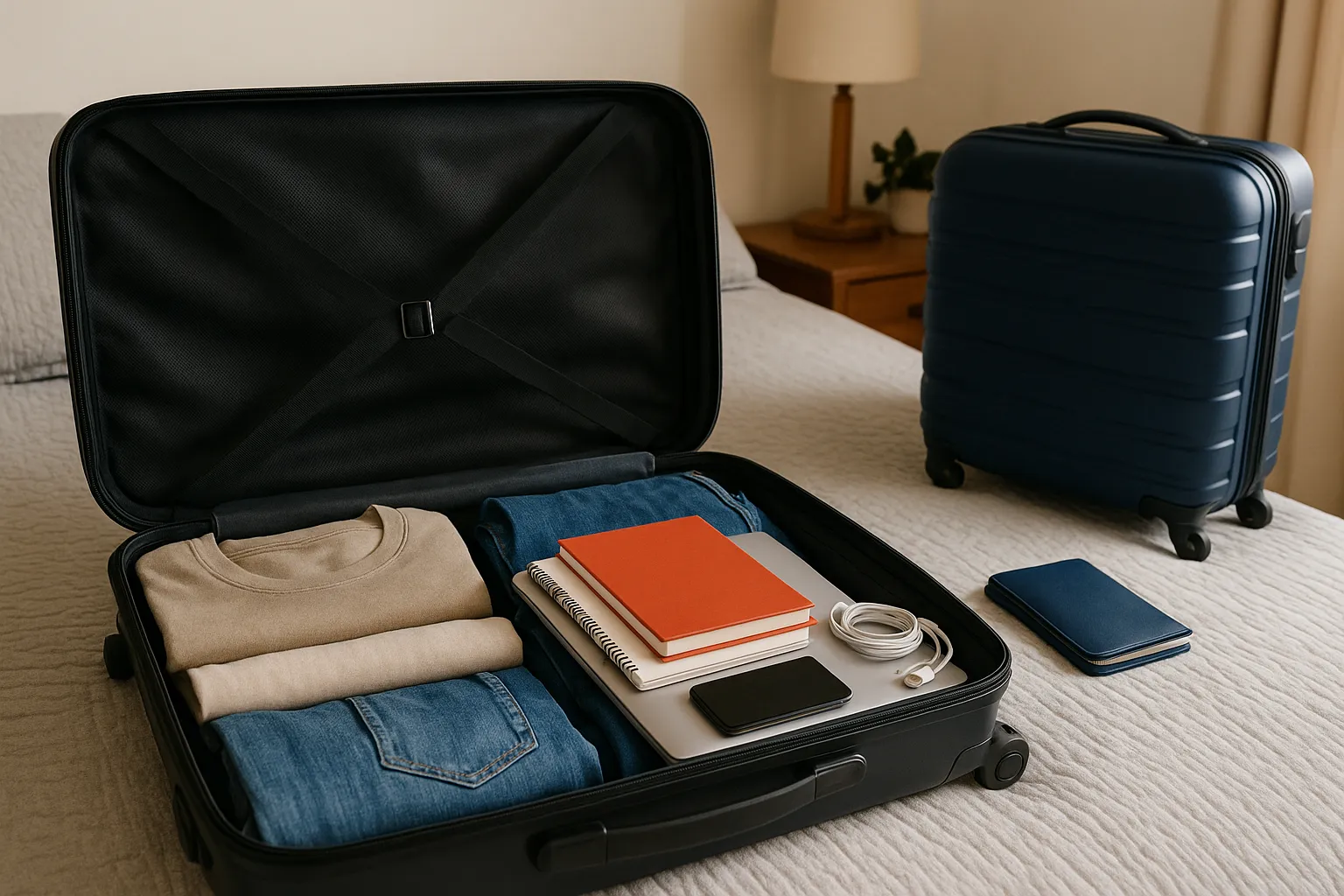Ready to go study abroad and wondering what to pack? You’re in luck. Today, we’re going to show you our complete guide to packing for studying abroad from the Highlands team of international education experts.
Don’t worry, packing for your big move is easy. In this guide, we’ll show you what to pack, what to leave, and how to make sure everything fits, and we’ll do it all in about 10 minutes.
You’ll even get some expert tips for making the most out of your international adventure from some of our successful alumni.
Ready? So are we. Let’s go
The Best Packing List for Studying Abroad
The right packing list helps you avoid overpacking, forgetting essentials, or stuffing your bag the night before your flight. It brings order to the chaos and gives you a clear plan. In this section, you’ll find what to pack, broken down by category, so you can get it done faster.
Clothing Essentials
- A few pairs of jeans, leggings, or comfortable pants
- Lightweight tops you can layer. Men often go for basic tees or polo shirts, while women might prefer tanks, blouses, or long-sleeve tops.
- A jacket or sweater for cooler weather
- Enough undergarments and socks
- Comfortable walking shoes
Pro Tip: Deduct your unnecessary clothes from the packing list. Think pieces you can certainly use. This saves time, space, and decisions later.
Tech Essentials

- Phone and charger
- Laptop or tablet
- Headphones or earphones
- Adapters that fit your host country’s outlets
Pro Tip: These are things you’ll use daily, both in class and while relaxing. Pack them all in your carry-on bag for safety.
Toiletries & Personal Care
- Travel-size shampoo, conditioner, toothpaste, and soap
- Sunscreen and basic skin care
- Deodorant, a hairbrush, and a razor
You can add more later if needed. These items aren’t expensive. Most of them are easy to find at nearby supermarkets or convenience stores. Don’t overload your bag with things you can pick up once you’ve settled in.
Important Documents
- Passport, visa, and student ID
- Printed insurance info and emergency contacts
- School forms or acceptance letters
Pro Tip: Put these in a folder inside your backpack or carry-on. You’ll need them at multiple checkpoints.
This list covers your packing essentials without weighing you down. Let’s break things down further and explore why these items matter.
How to Pack Light and Smart
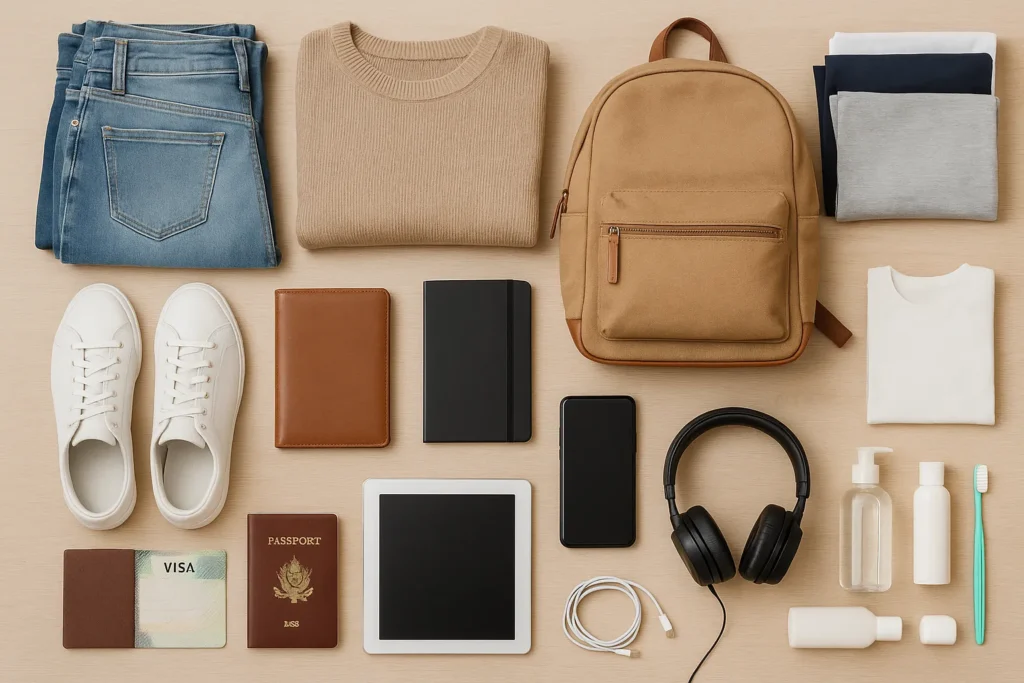
Let’s be honest, it’s easy to overpack. You think, “Maybe I’ll need this,” or “What if I go hiking or get invited somewhere fancy?” But the truth is, you probably won’t. Packing light is all about bringing what works best for you.
A student from last year’s program shared their experience with us. They said, “I packed half my wardrobe, but only wore the same six outfits. I ended up paying extra to ship things home.” So here’s how to keep it simple and still feel prepared.
Choose Clothes That Layer Well
Pick clothes that you can wear in different combinations. It’s no use planning one outfit for every scenario. A couple of T-shirts, dresses, a sweatshirt, and a light jacket will carry you through most weather. You don’t need separate clothes for every temperature if your pieces can be layered.
For example, you can pack one hoodie and a lightweight waterproof jacket instead of bringing multiple bulky jumpers.
Use Packing Cubes to Stay Organised
A packing cube is a small, zippered fabric container that helps keep your clothes neatly grouped. They’re usually lightweight and come in different sizes. Packing cubes help you sort your things and make the most of your space. You can separate socks from shirts, or clean clothes from used ones. The best part is you won’t have to repack everything each time you move.
Limit Bulky Shoes to One Pair
Don’t you think shoes take up more space, especially heavy ones like boots or trainers? So, choose one reliable pair for walking, and maybe one lighter pair for class or casual wear. If one pair is heavier, you can wear it during travel days to free up room in your luggage.
Skip the “Just in Case” Stuff
If you don’t use it at home every week, you probably won’t use it abroad either. Things like extra cables, gadgets, or three types of lotion sound useful, but rarely are. You can buy most of these items at your destination if it turns out you need them after all.
Pick a Smaller Bag and Stick to It
The size of your suitcase can make or break your trip. You should start with a smaller bag to begin, and pack only what fits inside. A more compact bag is easier to carry, quicker to pack, and simpler to manage on trains, buses, or crowded airport lines. When your bag is easier to manage, your days are too.
Up next: the documents and papers you’ll need to keep with you at all times.
Don’t Forget These Important Papers
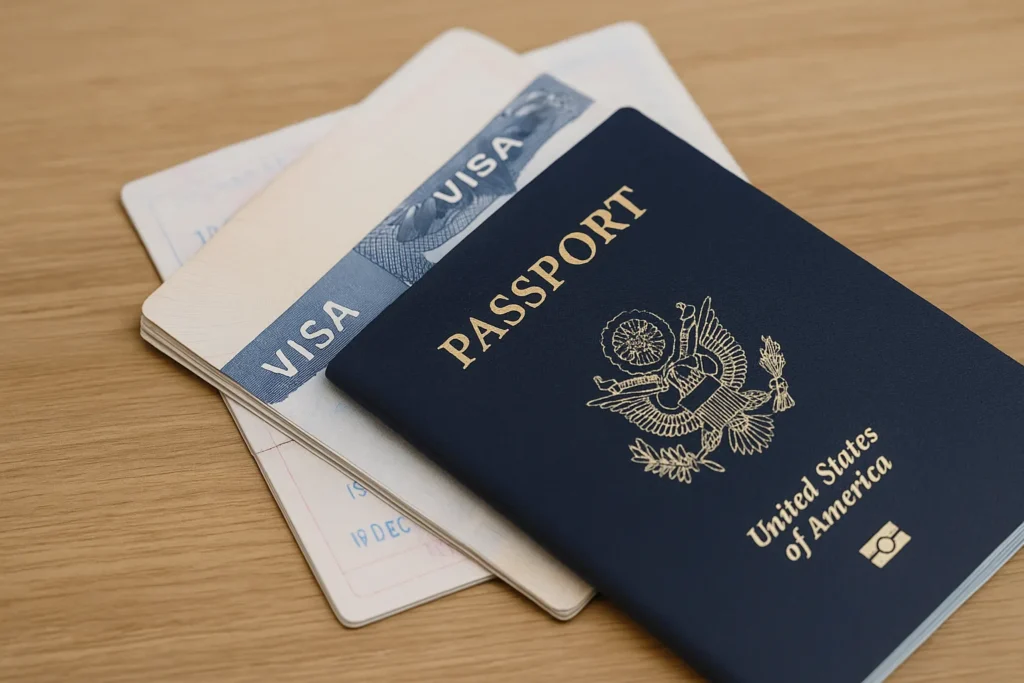
Before your flight, double-check important documents like your passport, student ID, or visa. You’d be surprised how often students forget an important paper and end up dealing with difficulties.
In a foreign land, nobody wants to face long delays or stressful check-ins. These papers are your proof of identity, enrollment, and access to help if things go wrong.
Let’s take a look at what you need to bring and why it’s worth the space in your bag:
Passport
This one is obvious, but still easy to overlook in a last-minute rush. Your passport should be valid for at least six months beyond your planned return date. Some countries won’t even let you in if it’s too close to expiring.
Keep your actual passport in your carry-on, but also make 2–3 photocopies. Store one in your checked bag, one in a safe folder with your paperwork, and email yourself a scan just in case.
Visa or entry permit
If your host country requires a visa, bring the original document and a printed copy. Border officers might ask for it at the airport, and your university could need to see it, too.
If you were sent a temporary approval letter or a confirmation email, print that out as well. Keep everything together in one pouch so you’re not digging through a messy folder when someone asks for it.
School enrollment documents
These include your acceptance letter, confirmation of registration, or orientation instructions. Print them all. These documents can smooth over any hiccups during check-in, course selection, or meetings with your international advisor.
One student once told us her name was spelled wrong in the system, but showing her original paperwork helped clear things up fast.
Student ID
If your school sent your student ID before you left, pack it. If not, bring your home university ID just in case.
During your first few weeks, you’ll likely need it for accessing campus facilities, getting discounts on public transport, or verifying your status when signing up for local services.
Travel insurance policy and contacts
Your travel insurance is also important. Print the full policy and highlight essential parts like emergency medical help or lost luggage claims.
If something goes wrong, you want to have those phone numbers ready.
Emergency contact sheet
Phones can get lost, run out of battery, or stop working with foreign SIM cards. Carry a paper with the names and phone numbers of your people:
- A family member or guardian
- Your academic advisor or program contact from your home university
- A support contact from your host school (like the international office)
- Local emergency services, once you know them
Printed copies of everything
For all of the above, make a couple of extra hard copies. One should go in your backpack or carry-on, and another in your checked luggage.
You might also leave one copy with someone you trust at home, just in case.
Digital backups
Scan or take clear photos of every document and upload them to a cloud folder like Google Drive or Dropbox. If possible, save everything on a small USB flash drive too and keep it in a side pocket of your bag.
It’s light, takes up no space, and can be a lifesaver when you least expect it.
Tip: Keep scans of all important documents as digital backups in your cloud storage and a backup on a flash drive.
Organising your important documents now avoids problems later. Next, we’ll go through what should be in your first aid kit.
What to Put in Your First Aid Kit
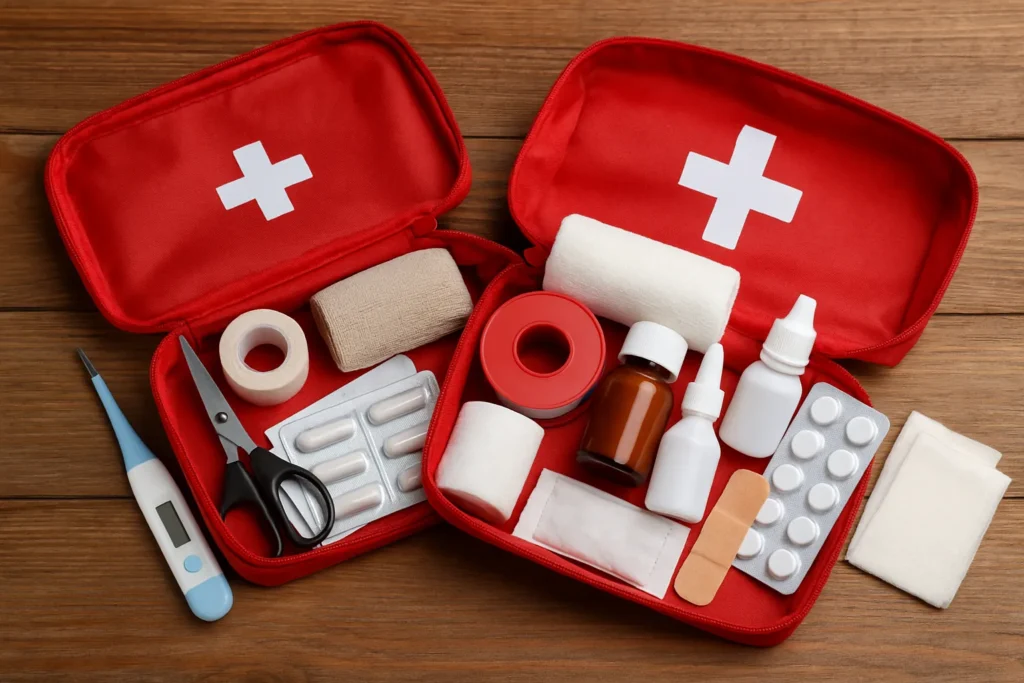
When putting together your study abroad packing list, don’t skip over the first aid kit. If you need something at night or aren’t sure where the nearest pharmacy is, you’ll be glad you brought it. This little kit can save you time, stress, and even money when you’re far from home.
See the list below to know what’s worth including and why:
- A few bandages in different sizes come in handy when you get a small cut or blister from walking all day.
- Basic pain relief, like ibuprofen or paracetamol, is useful for headaches, sore muscles, or period pain when you just want to rest.
- Antiseptic wipes or cream help clean up small cuts or scrapes when soap and water aren’t available nearby.
- A couple of cold and flu tablets will help you feel better faster if you catch a bug and want to stay ahead of it.
- Allergy medicine is great to have if you deal with pollen, dust, or food sensitivities, especially in new environments.
- A small bottle of insect repellent is worth packing if you’re going anywhere warm or plan to spend time outdoors.
- A digital thermometer is helpful when you’re not sure if you just feel tired or actually have a fever.
- Any prescription medications should be packed in their original packaging, along with a copy of your written prescription.
- A small bottle of hand sanitiser and a pack of tissues will come in handy more often than you’d expect, especially in public bathrooms.
Every travel style is different. But these basics work whether you’re on campus or exploring your new culture. Keep the kit small and simple. You’re not setting up a pharmacy, just covering yourself for everyday bumps.
Toiletries That Make Sense to Pack
A smart study abroad packing list isn’t complete without the right toiletries. When living in another country, the goal is to travel light while still feeling like yourself. Toiletries can quickly fill up space and add extra weight. So, it’s essential to be thoughtful about what needs to come with you and what can wait until you arrive.
Start with the basics you’ll need for the first few days. Travel-size shampoo bottles, conditioner, body wash, and toothpaste are perfect for your first week. They keep things light, so you’re not weighing down your luggage with full-size bottles. Once settled, you can easily pick up replacements at a nearby store or pharmacy.
Deodorant, your regular toothbrush, a razor, and any other personal hygiene items you use every day are good to pack from home. Having your go-to products with you during the first week brings some comfort while adjusting to a new place.
If you’re particular about skincare, pack a moisturiser and sunscreen that suits your skin type. Sometimes it’s hard to find the exact formula you’re used to, and switching products suddenly can be frustrating.
Lastly, consider bringing a small bar of laundry soap or a travel-sized detergent. It’s incredibly helpful for quick washes in a hostel sink or in between scheduled laundry days. Yes, you won’t use it every day. However, the first time you spill coffee on your only clean shirt, you’ll be glad it’s in your bag.
Toiletries are the easiest to replace. Stick with what you truly use and keep it simple. You’ll have more room for the things that matter. And your bag will feel a lot lighter when you’re moving from place to place.
Next, let’s walk through what to pack in your carry-on so you’re comfortable and prepared from takeoff to arrival.
What to Pack in Your Carry-On Bag
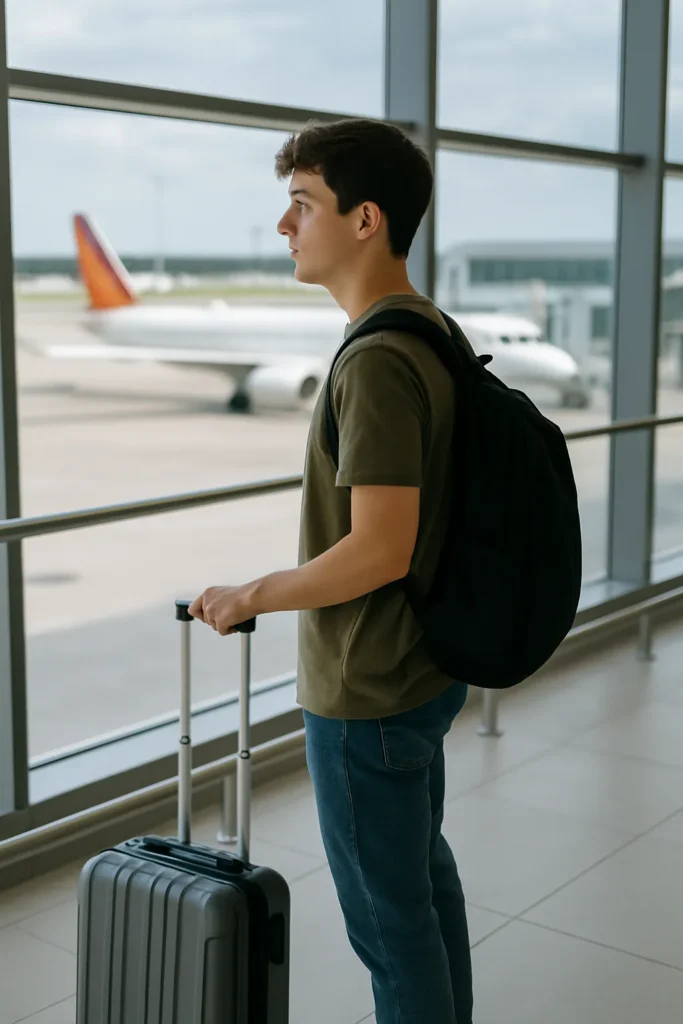
Most lost luggage stories start with an overpacked suitcase and a forgotten carry-on bag. Don’t let that be you. Your carry-on bag is your survival kit for the trip. If your luggage is delayed or you need to show documents at customs, what you’ve packed here will make all the difference.
Start with the essentials:
- Important documents: Your passport, visa, and student ID should be at the top of your bag. Keep a printed copy of emergency contacts and travel insurance details in case your phone battery dies.
- Snacks and water: Pack a few light snacks like protein bars or dried fruit, as airport food is limited or overpriced. Don’t forget an empty water bottle. Refill your water bottle after security. Staying hydrated helps with jet lag and makes everything feel a little easier.
- Tech and backup gear: Include your phone, charger, and any must-have electronics. If you’re bringing a camera or tablet, put them here. Add a small flash drive with digital copies of your documents.
Comfort items:
A lip balm, face wipes, and a clean pair of socks can keep you feeling fresh during a long trip. If you wear contacts or glasses, keep your case and solution handy too. You can’t plan for everything, but a well-packed carry-on gives you control over the first leg of your journey.
Let’s now talk about a few personal items and extras that often get forgotten.
Other Personal and Miscellaneous Items
Once you’ve packed the basics, there are a few personal items that can really improve your day-to-day experience abroad. These often get overlooked but can save time, add comfort, or simply make you feel more at home.
Pack a small day pack:
A small day pack or lightweight backpack is something you’ll likely use every day. Whether you’re going to class, heading on a weekend trip, or just walking around the city, having a comfortable bag for water, books, or a light jacket makes life easier.
Personal items worth including:
- E-reader or small book:.Your e-reader or a favourite book can make long commutes or downtime feel more relaxing. It’s a great way to unwind or catch up on reading when you’re on the go.
- Waterproof jacket: Weather can change fast. A packable rain jacket keeps you dry without taking up much room.
- Clothing for layering: If you’re heading somewhere cold or expect varied temperatures, pack one or two heavier items like a fleece or warm jumper. Layering helps you stay warm without having to pack a bulky coat.
- Notebook and pens: You’ll want to jot things down, whether it’s class notes or your first phrase in a new language.
Bonus tip: Bring a few small items that feel personal (like photos, a small keepsake, or your go-to snack from home). They take up little space and can be comforting when everything else feels new.
Next, we’ll go over some final tips to keep your bags light and your focus on the experience ahead.
Final Advice to Keep You Focused and Light
A complete study abroad packing list should help you feel prepared without making your bags too heavy to manage. Once you’ve packed the basics, take a few extra minutes to look over everything and ask yourself if it’s worth carrying.
Keep your bag light by choosing items you use often and feel comfortable wearing or using every day. This makes unpacking easier and helps you settle into your new routine more smoothly. Stick with pieces that work for more than one activity, and leave room for new things you’ll pick up during your stay.
Staying organised will help more than you think. A small folder for your documents and a simple system for keeping your things in order will save you time and stress once you arrive.
Now that your list is ready and your bag is nearly packed, take a moment to feel proud of how far you’ve come. You’re not just preparing for a trip. You’re preparing for a big life experience.
Want more practical help for your journey? Visit Highlands Golf Course for extra tips and useful planning guides before takeoff.
